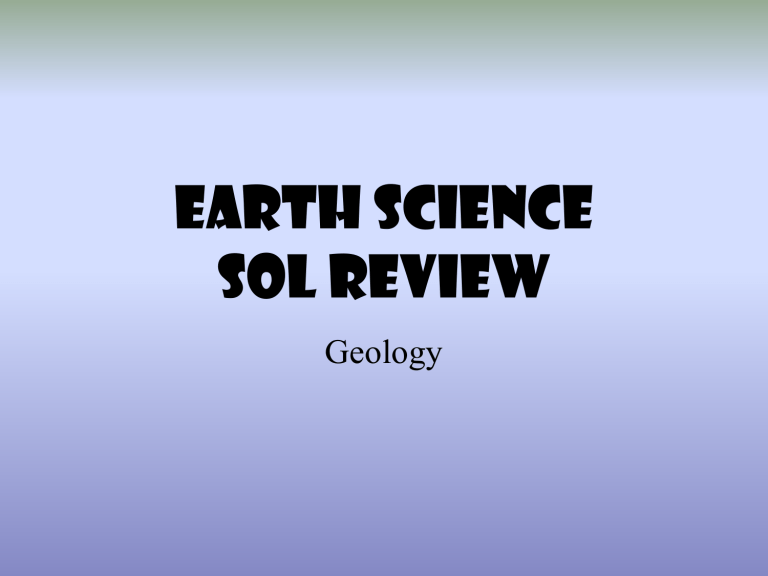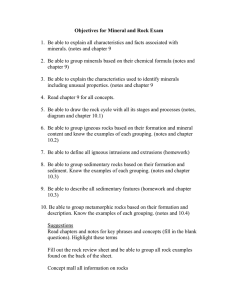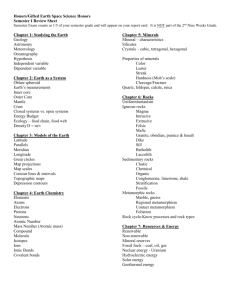EARTH SCIENCE SOL REVIEW Geology

EARTH SCIENCE
SOL REVIEW
Geology
Rocks and
Minerals
To Be a Mineral:
1. Naturally occurring
2. Inorganic
3. Solid
4. Has a definite (unchanging) chemical composition
5. Has a definite (unchanging) structure
Physical Properties of
Minerals
You can identify minerals by their physical properties (tests)
Specific Mineral
Information
Minerals are nonrenewable resources.
Silicates are the most abundant mineral group.
An ore is a material that is useful and profitable.
Pyrite
Hematite Magnetite
Halite
Graphite
Sulfur
More Mineral
Information
Gems are rare and beautiful. All share extreme hardness as a physical property.
Calcite fizzes with acid and exhibits double refraction. It is the major mineral of limestone.
Quartz is the major mineral of glass and sand.
Ye Olde Rock Cycle
Igneous Rocks
Igneous rocks form from the cooling and crystallization of molten rock
(magma, lava)
Intrusive Igneous Rocks—slow cooling of magma inside the Earth. Coarse-grained texture (large crystals) GRANITE
Extrusive Igneous Rocks—quick cooling of lava outside the Earth. Small crystals and fine-grained texture. May look glassy or have holes present. PUMICE, OBSIDIAN,
BASALT
Sedimentary Rocks
Sedimentary rocks form from rock fragments or organic matter, or are formed by chemical precipitation.
Weathering, erosion, cementation, and compaction are the processes of sedimentary rock formation.
They build up in layers called strata, and fossils are found in them.
Types of Sedimentary Rocks
Clastic rocks—made of fragments of other rocks
Conglomerate (pictured)—rounded pebbles;
Sandstone—sand; Shale—made of compacted clays
Organic rocks—made from past living sources
Limestone—microscopic sea animals; Coal (pictured)— fossilized swamp plant material
Chemical rocks—formed from precipitation or evaporation of liquids
Limestone—cave structures; Halides and Rock Salt
(pictured)—evaporation of water
Metamorphic Rocks
Metamorphic Rocks are formed from heat and pressure on existing rocks.
Contact metamorphism— small area in contact with an igneous intrusion “bakes” the rock and changes it.
Regional metamorphism— large area changed due to heat and pressure. Usually with mountains.
Foliated texture (shown)—bands or layers of minerals. SCHIST,
SLATE, GNEISS
Nonfoliated texture—no layers. These rocks have made a complete atomic change. MARBLE, QUARTZITE
Weathering, Erosion, and Deposition
Mechanical Weathering—broken down
Into pieces without a chemical change
Frost (Ice) Wedging
Chemical Weathering—changed into
Something chemically different
Oxidation (rust)
Erosion—the breakdown and transport of Earth materials by wind, water, gravity, glaciers. Erosion is greatest in high relief areas (steep). Greatest agent of erosion is water. Glaciers erode by plucking, wind erodes by abrasion and deflation, and gravity creates mass movements like slump, creep, mudflows, and rockslides.
Deposition—the dropping of Earth materials after energy of motion of agent of erosion decreases to the point where it cannot carry materials any longer. Deposition is greatest in low relief areas—flat and low and at sea level.
DELTA
Depositional Landforms
ALLUVIAL FAN
BEACHES AND DUNES
BARRIER ISLAND
Sediment Sizes
Sedimentary Rock Trivia:
*Limestone is the only rock formed in 2 different ways
(chemical and organic)
*The 3 major rock resources of Virginia are Limestone,
Coal, and Titanium
*Coal formation—PEAT changes to LIGNITE which changes to BITUMINOUS which changes to
ANTHRACITE (the hardest coal)
Smallest—clay then silt then sand then gravels
Clay is the smallest, so it will settle out last. Gravel is the largest, so it will settle out first.
Sediments will settle out when there is no longer enough energy of motion to carry them.
Soil
A horizon—humus and dark in color
(topsoil)
B horizon—lighter in color and leaching has brought minerals down from topsoil
C horizon—weathered parent material
Soil is formed from weathering of rock and from organic activity
Soil is loose fragments of rock and clay derived from weathered rock mixed with organic material (humus)
Water
Water, cont.
Most of the water on Earth is salt water (97%)
2% is locked up in the ice caps
1% is fresh water we can drink—most of this is found in the ground
Earth’s freshwater is renewable yet finite (the actual amount does not change)
Water Pollution—
Point Source (direct sources)
Non-Point Source (runoff)
Porosity and
Permeability
Porosity—amount of pore space in a material. Materials made of rounded particles have a lot of pore space. Materials like clay that are flat and angular have less pore space. The amount of pore space is greater if particles are the same size rather than if mixed sizes are present.
Permeability—the ability of a material to transmit water. Well-sorted (same size and shape) materials are very permeable (GRAVEL and SAND).
Impermeable—water does not pass through this material—clay packs are very flat, so even though there is pore space, the pores are not connected
Groundwater
Soil is considered the zone of aeration
Water Table is one top of the zone of saturation
Aquifer—layer of rock that stores and transports water freely
Karst Topography
Karst includes features like caves, sinkholes, and streams caused by moving groundwater.
Karst forms when
Carbonic acid (CO
2
+ H
2
O) dissolves limestone and dolomite
Spring—where the water table meets the surface
Virginia Geology
Virginia Geology, cont.
Virginia has a 3 billion year history and contains fossils from the Paleozoic,
Mesozoic, and Cenozoic Eras.
Coastal Plain is the youngest part of VA. Sediments from the Appalachian
Mountains have created the VA beaches. Fossils are abundant in the Coastal Plain, and it is a high deposition area because of its low elevation.
Piedmont is separated from the Coastal Plain by a Fall Line. The Piedmont contains high levels of igneous and metamorphic rocks.
Virginia Geology, cont.
Most fossils in VA are marine, indicating that VA was once under seawater.
Fossils are found in sedimentary rocks in the CP, VR, and AP provinces.
Paleozoic, Mesozoic, and
Cenozoic fossils have all been found.
Blue Ridge is the oldest area of the state of VA. Blue Ridge was the result of North
America and Africa colliding. Blue Ridge is also an igneous and metamorphic rockdominated area.
Valley and Ridge has folded mountains that were formed during the collision of North
America and Africa. The collision produced the Appalachian Mountains. Due to high concentrations of limestone/dolomite, karst topography is dominant. Many fossils in
Valley and Ridge.
Appalachian Plateau has irregular ridges and faults. Fossils and coal deposits are plentiful.
Plate Tectonics
Boundaries, Volcanoes, Earthquakes
Plate Boundaries on Earth
Layers of Earth
Inner core is solid and made of iron and nickel
Outer core is liquid and made of Fe, N, and lighter elements
Mantle is largest layer and is plastic-like
(asthenosphere)
Two (2) types of crust— continental (made of silicon and oxygen) and oceanic (made of iron and magnesium)
The Lithosphere
Ocean crust is more dense than continental crust and it always goes under the continental crust when they collide
(SUBDUCTION ZONES)
Ocean crust is younger than continental crust. Youngest area of ocean floor is at midocean ridges
Ocean crust is thinner than continental crust
The lithosphere is the crust and the upper mantle. The lithosphere is divided into plates. The plates move because of convection currents (shown above).
Convection is the major mechanism of energy transfer in the oceans, atmosphere, and Earth’s interior.
Convection currents are when hot, less dense material rises, cools, becomes more dense and sinks.
Plate Boundaries: Where
Plates Come Together
Dividing plates. Mid-ocean ridges, sea floor spreading, rift valleys, and volcanoes.
Slide past each other.
Earthquakes and strike-slip faults.
Most earthquakes and volcanoes are found on plate boundaries
Three (3) Types of
Convergent Boundaries
Trenches, volcanic arcs and subduction zones. Ocean plates always go under continental plates.
Folded mountains, thrust-block mountains
Trenches, subduction zones, volcanic island arcs
Volcanoes
Volcanoes form primarily from subduction activity and magma rising at divergent plate boundaries. They are also produced by hot spots, which are mantle plumes of rising magma at the center of a lithospheric plate. Older volcanoes are further from a hot spot due to plate movement.
Earthquakes
Three (3) seismograph stations are needed to locate the epicenter of an earthquake
Earthquakes result when movement occurs along faults (breaks or cracks in the Earth’s crust) and boundaries.
The epicenter is the point on the surface directly above the focus where energy is released.
P-waves (compression) travel faster than S-waves
S-waves (side to side) will not travel through liquid
L-waves are surface waves and cause the most damage
Shadow zone is where no waves are received
Richter Scale measures magnitude
(energy released)
Mercalli Intensity Scale explains the damage of an earthquake
Mountains
Appalachian Mountains are folded mountains
Geologic History
Fossils
• Fossils can be preserved as
– Molds—cavity
– Casts—3D replica of organism
– Original—actual animal in ice, amber, or tar pit
– Petrified—material is replaced by minerals
– Index fossils—we date rock layers because these were very abundant, worldwide, and short-lived.
Relative Dating
Putting events in order or sequence without assigning an exact age.
Law of Superposition
In an undisturbed rock sequence, the oldest layers are on the bottom and get younger as you go up.
Law of Cross-Cutting Relationships
Igneous intrusion (and fault) is younger than the layers it cuts across
Absolute Dating
Placing an exact age on a material, usually through radioactive or radiometric dating
Carbon-14 dating is used for dating organic material up to
50,000 years old.
Uranium—dates the oldest rocks—up to 4.5 billion years
Half-life is the amount of time it takes for 50% of a radioactive parent isotope to break down into its stable daughter product
Geologic Time
We break down Geologic Time into—Eras (largest division…ends with extinction events), Periods (based on Index Fossils), and
Epochs (smallest…based on types of life and is found only in
Cenozoic Era)
Precambrian Era—90% of all geologic history. In the beginning, our planet had no oxygen. Carbon dioxide was the major gas.
Cyanobacteria—descendants of blue-green algae-produced oxygen that lead to creation of ozone layer and an atmosphere that supported life
Paleozoic Era—Age of Invertebrates and the creation of Pangaea
Mesozoic Era—Age of Reptiles—dinosaurs dominate and Pangaea breaks apart
Cenozoic Era—Age of Mammals—man comes into existence
We live in the Cenozoic Era, in the Quaternary Period, in the
Recent Epoch



